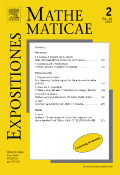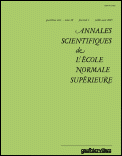
International Electronic Journal of Geometry
Scope & Guideline
Fostering Innovation in Mathematical Research
Introduction
Aims and Scopes
- Differential Geometry:
The journal extensively covers differential geometry, exploring the properties and applications of curves and surfaces in various geometric settings, including Riemannian and pseudo-Riemannian manifolds. - Geometric Analysis:
Papers often delve into geometric analysis, examining the interplay between geometric structures and analytical techniques, particularly in the context of solitons and curvature conditions. - Curvature and Topology:
Research frequently investigates curvature properties and their implications for the topology of manifolds, including studies on sectional curvature, Ricci curvature, and various curvature inequalities. - Submanifold Theory:
The journal includes significant contributions to the theory of submanifolds, focusing on classifications, properties, and special types of submanifolds in different ambient spaces. - Mathematical Physics Applications:
There is a consistent focus on the applications of geometric theories to mathematical physics, particularly in areas like general relativity and theoretical mechanics. - Statistical Geometry:
Emerging topics also include statistical geometry, where geometric concepts are applied to statistical models and distributions, enhancing comprehension of geometric structures in probabilistic contexts.
Trending and Emerging
- Solitons and Geometric Flows:
Recent papers have increasingly focused on solitons and geometric flows, exploring their properties in various geometric contexts, which suggests a growing interest in dynamic geometric phenomena. - CR Geometry and Submanifolds:
There is a notable uptick in research related to CR geometry and CR submanifolds, reflecting a rising interest in complex geometry and its applications across mathematical disciplines. - Statistical and Fuzzy Geometry:
Emerging themes in statistical geometry and fuzzy geometric models are gaining traction, indicating a shift towards integrating statistical methods with geometric analysis. - Higher Dimensional Manifolds:
Research on higher-dimensional manifolds and their peculiarities has become more prominent, showcasing an expansion of interest beyond traditional three-dimensional spaces. - Interdisciplinary Applications:
An increasing number of studies are exploring the interdisciplinary applications of geometry, particularly in mathematical physics and engineering, highlighting the practical implications of geometric research.
Declining or Waning
- Classical Geometric Constructions:
Themes related to classical geometric constructions and properties, such as traditional Euclidean constructions, have become less frequent, possibly overshadowed by more abstract and complex geometric studies. - Elementary Geometry:
Papers focusing on elementary geometric principles and their straightforward applications have decreased, indicating a shift towards more advanced and specialized topics in geometry. - Static Geometric Models:
Research on static geometric models, particularly those that do not incorporate dynamic or physical applications, appears to be waning, as the journal increasingly embraces more dynamic and application-oriented studies.
Similar Journals

EXPOSITIONES MATHEMATICAE
Unveiling New Perspectives in MathematicsEXPOSITIONES MATHEMATICAE, published by Elsevier GmbH, stands as a significant journal in the realm of mathematics, catering primarily to researchers, professionals, and students. With an ISSN of 0723-0869 and an E-ISSN of 1878-0792, this journal has made its mark in the academic community, boasting a Q2 classification in the miscellaneous mathematics category for 2023, illustrating its prominence within its field. The journal addresses a diverse scope of mathematical topics, encouraging the publication of original research and innovative theories while maintaining rigorous academic standards. As it converges from 2004 to 2024, EXPOSITIONES MATHEMATICAE continues to be an essential resource for advancing mathematical knowledge and fostering scholarly communication, despite being a non-open-access publication. Its location in Munich, Germany further anchors it within a rich intellectual tradition, providing accessibility for the mathematical community worldwide.

JOURNAL OF GEOMETRIC ANALYSIS
Pioneering Innovative Approaches in Geometric AnalysisJOURNAL OF GEOMETRIC ANALYSIS, published by SPRINGER, stands as a premier platform for the dissemination of high-quality research in the field of geometric analysis. With its ISSN 1050-6926 and E-ISSN 1559-002X, this prestigious journal has maintained a robust academic reputation since its inception in 1991, boasting a convergence of ideas and research that will continue through 2024. It is categorized in the top quartile (Q1) of Geometry and Topology, highlighting its significance and influence in the mathematical community. Ranking 23rd out of 106 in its field, and placing in the 78th percentile according to Scopus metrics, this publication is essential for researchers, professionals, and students who seek to deepen their understanding of geometric structures and their applications. Though it operates under a subscription model rather than Open Access, the journal consistently aims to advance knowledge through rigorous peer-reviewed articles that explore the latest developments and methodologies in geometric analysis, making it a pivotal resource for anyone involved in mathematical research.

ANNALES DE L INSTITUT FOURIER
Unveiling New Perspectives in Algebra and GeometryANNALES DE L INSTITUT FOURIER is a premier academic journal published by ANNALES INST FOURIER, specializing in the fields of Algebra and Number Theory as well as Geometry and Topology. Since its establishment, the journal has garnered a distinguished reputation, evidenced by its Q1 quartile ranking in the 2023 category assessments and its Scopus Rank of #37 out of 119 in Algebra and Number Theory, and #34 out of 106 in Geometry and Topology, placing it within the top percentile of its field. The journal serves as a vital platform for disseminating groundbreaking research and innovative methodologies, catering to a global audience of researchers, professionals, and students. With a commitment to the advancement of mathematical sciences, ANNALES DE L INSTITUT FOURIER invites contributions that push the boundaries of knowledge and foster collaboration across disciplines. Although it does not offer open access, the rigorous peer-review process ensures that published papers meet the highest academic standards, making it a critical resource for anyone engaged in advanced mathematical research.

MICHIGAN MATHEMATICAL JOURNAL
Pioneering Insights in the World of MathematicsThe MICHIGAN MATHEMATICAL JOURNAL is a prestigious and influential publication in the field of mathematics, founded by the University of Michigan. With an ISSN of 0026-2285 and an E-ISSN of 1945-2365, this journal is recognized for its high-quality research and has achieved a commendable Q1 ranking in the category of Mathematics (miscellaneous) as of 2023. Published by the esteemed Michigan Mathematical Journal, it provides a platform for the dissemination of innovative mathematical theories and findings, playing a crucial role in advancing knowledge and scholarship within the mathematical community. With coverage spanning from 1996 to 2024, the journal emphasizes rigorous theoretical development and fosters collaboration among researchers, professionals, and students alike. While not an open-access journal, its contributions are invaluable for those looking to stay abreast of cutting-edge mathematical research.

ANNALES SCIENTIFIQUES DE L ECOLE NORMALE SUPERIEURE
Unleashing the Power of Mathematical ResearchANNALES SCIENTIFIQUES DE L ECOLE NORMALE SUPERIEURE is a distinguished journal published by the Société Mathématique de France, dedicated to advancing the field of mathematics through high-quality research articles. With a robust impact factor and categorized as Q1 in Mathematics (Miscellaneous) as of 2023, this journal ranks in the top 16% of mathematics publications, showcasing its importance and influence in the discipline. Available in both print (ISSN: 0012-9593) and electronic formats (E-ISSN: 1873-2151), ANNALES SCIENTIFIQUES serves as a central hub for innovative mathematical theories and methodologies, appealing to a diverse audience of researchers, professionals, and students alike. The journal publishes research that spans various domains within mathematics, fostering a collaborative environment for idea exchange. As it converges from 1997 to 2024, it continues to shape the mathematical landscape, providing essential insights and developments within the global academic community. Located in Paris, France, the journal invites contributions that push boundaries and advance the understanding of complex mathematical concepts.

Annals of PDE
Unlocking the Secrets of Mathematics and PhysicsThe Annals of PDE, published by SpringerNature, is a premier academic journal dedicated to the field of partial differential equations, encompassing areas such as Analysis, Applied Mathematics, Geometry and Topology, and Mathematical Physics. Since its inception in 2015, the journal has established itself as a vital resource for researchers and professionals seeking to disseminate cutting-edge findings in these rapidly evolving disciplines. With a remarkable Q1 ranking across multiple categories in 2023, including Mathematics and Physics and Astronomy, the Annals of PDE positions itself at the forefront of academic scholarship, as evidenced by its notable Scopus rankings, such as 7th percentile in Geometry and Topology. The journal offers a platform for open access to its articles, making it accessible to a global audience, and fostering collaborative advancements in the understanding and application of partial differential equations. Its contributions are invaluable for advancing theoretical and practical knowledge in mathematics and physics, making it an essential read for students, researchers, and professionals alike.

GEOMETRIC AND FUNCTIONAL ANALYSIS
Connecting Ideas, Transforming MathematicsGeometric and Functional Analysis, ISSN 1016-443X, is a prestigious academic journal published by Springer Basel AG in Switzerland, renowned for its impactful contributions to the fields of geometry and analysis. With a notable Q1 ranking in both Analysis and Geometry and Topology, the journal has established itself as a leading voice in the mathematical community, garnering respect and attention with its Scopus classification — ranking 6th in Geometry and Topology and 26th in Analysis. Since its inception in 1991, it has served as a platform for rigorous research, presenting original articles that push the boundaries of mathematical understanding. Researchers, professionals, and students seeking high-quality, peer-reviewed content in these domains will find valuable insights and developments within its pages. While primarily subscription-based, the journal's extensive reach and influence make it an essential resource for advancing knowledge in geometric and functional analysis.

TOHOKU MATHEMATICAL JOURNAL
Fostering Innovation in Mathematical ResearchTOHOKU MATHEMATICAL JOURNAL, published by TOHOKU UNIVERSITY, is a distinguished academic journal committed to the advancement of mathematical research. Established in 1949, the journal has sustained a long-standing tradition of disseminating high-quality, peer-reviewed articles that contribute significantly to various branches of mathematics. With its scope encompassing a broad range of topics within the field, TOHOKU MATHEMATICAL JOURNAL aims to foster intellectual exchange and innovation among mathematicians worldwide. Though currently not an open-access publication, it is indexed in Scopus, holding a respectable Q2 ranking in the miscellaneous mathematics category as of 2023, which signifies its relevance and influence in the academic community. Researchers, professionals, and students alike will find valuable insights and contemporary developments that reflect the journal's dedication to excellence in mathematical scholarship.

Journal of Geometry
Unveiling the Beauty of Shapes and SpacesJournal of Geometry, published by SPRINGER BASEL AG, is a prominent scholarly journal, ISSN 0047-2468 and E-ISSN 1420-8997, dedicated to the field of Geometry and Topology. Hailing from Switzerland, this journal has been a vital resource for researchers since its inception in 1971 and continues to contribute invaluable insights into geometric theories and applications through 2024. With a HIndex that reflects its academic impact, the journal currently ranks in the Q3 category for Geometry and Topology, placing it within the top half of publications in its field, as evidenced by its Scopus ranking of #71 out of 106 in Mathematics, Geometry, and Topology. The Journal of Geometry serves as a platform for original research, reviews, and special issues that address foundational and cutting-edge topics, making it an essential read for mathematicians, educators, and students alike. While it is not an open-access publication, the journal maintains accessibility through institutional subscriptions, ensuring that its significant contributions to geometry are readily available to the academic community.

PUBLICACIONS MATEMATIQUES
Advancing Mathematical FrontiersPUBLICACIONS MATEMATIQUES is a prestigious academic journal published by Universitat Autònoma de Barcelona, specializing in the diverse field of mathematics and its applications. With an esteemed Q1 ranking in Mathematics (miscellaneous) for 2023, this journal holds a significant position in the mathematical community, reflecting a commitment to high-quality research that spans both theoretical and practical aspects of mathematics. Although it operates without an Open Access model, it remains accessible to a global audience, featuring contributions that range from pure mathematical theories to interdisciplinary applications. Based in Spain, its influence and reach extend internationally, making it a vital resource for researchers, professionals, and students alike who seek to stay informed and engaged with cutting-edge developments in mathematics. The journal's continuous publication since 2002 further underscores its role in advancing mathematical research and fostering scholarly dialogue.